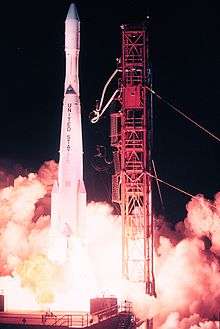ESSA-9
 ESSA-9 being checked out before launch | |
| Mission type | Meteorology |
|---|---|
| Operator |
ESSA (1969-70) NOAA (1970-72) |
| COSPAR ID | 1969-016A |
| SATCAT № | 3764 |
| Mission duration | 1,726 days[1] |
| Spacecraft properties | |
| Launch mass | 145 kilograms (320 lb) |
| Start of mission | |
| Launch date | 26 February 1969, 07:47:01 UTC[2] |
| Rocket | Delta E1 |
| Launch site | Cape Canaveral LC-17B |
| End of mission | |
| Disposal | Decommissioned |
| Deactivated | November 1972 |
| Orbital parameters | |
| Reference system | Geocentric |
| Regime | Low Earth |
| Semi-major axis | 7,843.18 kilometers (4,873.53 mi) |
| Eccentricity | 0.00508 |
| Perigee | 1,432 kilometers (890 mi) |
| Apogee | 1,512 kilometers (940 mi) |
| Inclination | 101.99 degrees |
| Period | 115.21 minutes |
| Mean motion | 12.49 |
| Epoch | 7 December 2013, 20:28:49 UTC[3] |
| Instruments | |
| Advanced Vidicon Camera System (AVCS), Flat Plate Radiometer (FPR)[4] | |
ESSA-9, also known as TOS-G, was a meteorological satellite.[5] ESSA-9 replaced the ESSA-7 satellite.
Launch & orbit
The ESSA-9 was launched on a three stage Delta rocket from Cape Canaveral, Florida. The launch occurred at 07:47 UTC (02:47 EDT) on 26 February 1969. The spacecraft was placed in a sun-synchronous orbit of 101.4° inclination. Immediately after launch ESSA-9 had a perigee of 1,427.0 kilometers (886.7 mi) and an apogee of 1,508.0 kilometers (937.0 mi), giving it an orbital period of 115.2 minutes, or a mean motion of 12.5 orbits per day.[2]
Spacecraft
The ESSA-9 spacecraft was similar to the TIROS series of satellites, having an 18-sided polygonal shape that measured 42 inches (110 cm) in diameter and 22 inches (56 cm) high. It weighed 320 pounds (150 kg). The body of the ESSA-9 was made of aluminum alloy and stainless steel. The shell of the craft was covered with 10,020 solar cells.[1] The solar cells recharged the 63 nickel–cadmium batteries during the time the spacecraft was in sunlight.[1] The ESSA-9 employed the same cartwheel-style stabilization as the TIROS-9 satellite. The satellite used a Magnetic Attitude Spin Coil (MASC) to control its attitude while in orbit. The magnetic field induced by the MASC's current interacted with the earth's magnetic field to provide the torque necessary to maintain a desired spin rate of 9.225 rpm.[6]
Instruments
The ESSA-9 carried two sets of two main instruments, the Advanced Vidicon Camera System (AVCS) and the Flat Plate Radiometer (FPR). The AVCS was used to collect imagery of cloud cover on earth. The cameras had a resolution of 2 miles (3.2 km) and covered an area of 2,000 square miles (5,200 km2). The cameras would take single images of a particular region of the earth's surface once a day. The FPR's were used to measure the global distribution of solar radiation reflected by the earth and the earth's atmosphere. They also measured long wave emissions from the earth. The sensors used in the ESSA satellites were from the earlier Nimbus program.

References
- 1 2 3 NASA Science page, ESSA-9
- 1 2 Launch info
- ↑ "ESSA 9 (TOS-G) Satellite details 1969-016A NORAD 3764". N2YO. 7 December 2013. Retrieved 8 December 2013.
- ↑ Experiments on ESSA-9
- ↑ http://www.tbs-satellite.com/tse/online/sat_essa_9.html
- ↑ Spacecraft details
